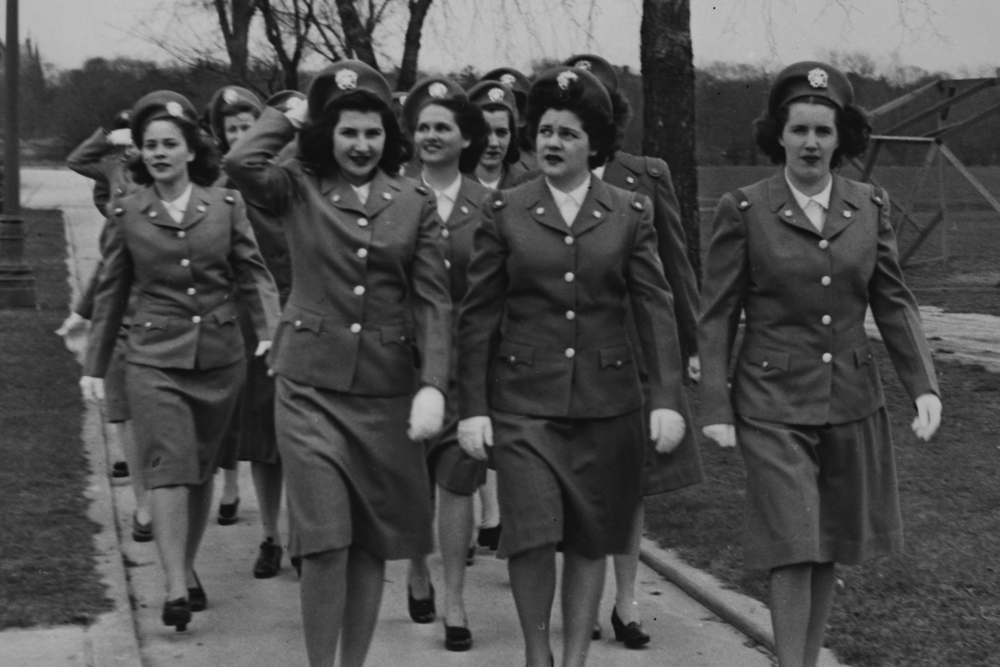During one of the centerpiece events of Adelphi's Nurses Week, two U.S. Cadet Nurse Corps veterans, Claire (Kantoff) Shulman '46 and Mary Dewar, took their audience on a journey back in time to when nursing schools were few and hospital equipment was comparatively primitive.
 During one of the centerpiece events of Adelphi’s Nurses Week, two U.S. Cadet Nurse Corps veterans, Claire (Kantoff) Shulman ’46 and Mary Dewar, took their audience on a journey back in time to when nursing schools were few and hospital equipment was comparatively primitive.
During one of the centerpiece events of Adelphi’s Nurses Week, two U.S. Cadet Nurse Corps veterans, Claire (Kantoff) Shulman ’46 and Mary Dewar, took their audience on a journey back in time to when nursing schools were few and hospital equipment was comparatively primitive.
Marilyn Klainberg ’63, M.S. ’77, Ed.D., who moderated the History Speaks event held in the Nexus Building’s Adelphi Room on April 25, first asked the veterans how the cadet corps had changed or influenced their lives.
“The cadet corps paid our way,” Dewar said. “I got my nursing education.”
Shulman said, “I grew up. I became mature. I left behind teenaged interests, including boyfriends.”
Dewar—who in 1970 also joined the faculty of the then-School of Nursing at Adelphi to teach community health nursing—said she became a cadet nurse in 1946, by which time World War II was over. While she didn’t go overseas to serve the war effort, she did travel the world to serve in other ways—first in China in the ’40s and in Angola in the ’50s, then in Northern Rhodesia and Ghana in the ’60s and Switzerland in 1968.
Nursing then, nursing now
When asked to compare their cadet nurse experience with nursing today, Dewar recalled that hospitals back then didn’t have recovery rooms or ICUs. After surgery, patients were simply returned to their beds. Nurses boiled and sharpened their own syringes because they only had one apiece, she added, and they mended their rubber gloves.
Shulman, who started her nursing career at Queens Hospital Center, recalled that each ward had 45 beds for 70 patients; the rest had to settle for cots. “You have all this wonderful equipment we didn’t have.” But, she added, “We learned to be creative.”
Today, Dewar observed, “There are all kinds of medications we never had.”
Citing the current measles outbreak and public health emergency in New York City involving a disease thought eradicated in the United States in 2000, she said, “Many of you have probably never seen measles.” Dewar, who had the measles before there was a vaccine, recalled that “50 percent of measles and whooping cough cases in Africa died,” in part, due to poor nutrition. “There were a whole lot of diseases overseas we never saw here [in the U.S.]…tuberculosis, leprosy, malaria.”
One lesson cadet nurses learned that’s still applicable today, Shulman said, is “you learn to listen to people and what they’re trying to tell you.” That’s complicated if the patients come from another country and there are language problems. “Diversity of the population is something that is relatively new.”
Through the years, Dewar agreed, “I learned a lot from the patients too, from their culture, what’s important to them, what’s not important to them.”
A lasting legacy
Dr. Klainberg asked what might be the cadet corps’ legacy today. Shulman said, “It created a lot of nursing schools. It created a lot of people going into the nursing profession.”
Dewar said, “We were at war at the time. The idea of service…is one of the major legacies of the corps.”
Today, Dewar advocates for New York state passage of universal healthcare, and Shulman—who was Queens Borough President for four terms, until 1997—serves on several hospital boards.
At the conclusion, Dr. Klainberg presented both cadet nurse veterans with proclamations from Nassau County Executive Laura Curran.
Irene (Auteri) Ferguson ’77, College of Nursing and Public Health coordinator for special projects, said in her introductory remarks that Mildred Montag, first director of nursing for the then-School of Nursing, found there was only one other nursing school “from Queens to Montauk.”
Before the conversation, Ferguson played a two-minute video (without audio) from the day of former first lady Eleanor Roosevelt’s May 1944 speech dedicating the two nursing dorm buildings, Alumnae Hall and Harvey Hall. She pointed out that, initially, funding was for just one dorm building. Later funding led to the second building—“That’s why it’s L-shaped,” she said.
In pursuit of memorabilia to display in the Nexus Building during Nurses Week, she said she had pestered University archivists for more. They found the video (which also shows the earliest buildings, Levermore Hall, Blodgett Hall and Woodruff Hall) as well as the transcript of the first lady’s address.